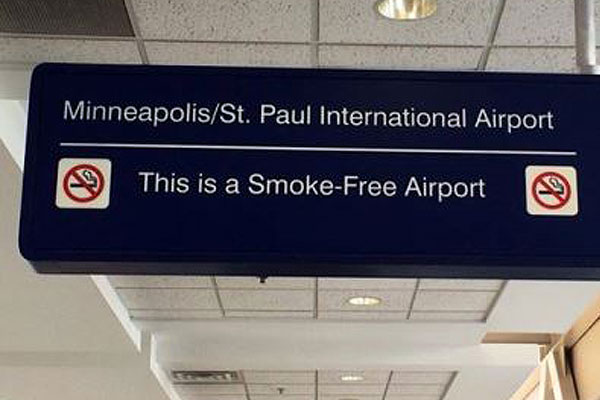Secondhand smoke poses a health risk to airline passengers and airport workers.
ATLANTA – Among the 50 busiest airports in the world, 23 have smoke-free indoor policies. This means air travelers and employees at 46 percent of the world's busiest airports are protected from exposure to secondhand smoke. The other 27 busiest airports allow smoking in designated or ventilated indoor areas.
The report published in Morbidity and Mortality Weekly Report (MMWR) is the Centers for Disease Control and Prevention's first assessment of smoke-free policies in the world's airports. More than 2.7 billion passengers annually pass through the airports included in the study.
Airports were defined as having a smoke-free policy if they completely prohibited smoking in all indoor areas. The 27 airports defined as having no smoke-free policy allowed smoking in designated smoking rooms, restaurants, bars, or airline clubs.
Smoke-free policies protect travelers, workers from secondhand smoke
"The Surgeon General has concluded there is no risk-free level of secondhand smoke exposure?," said Corinne Graffunder, D.Ph., M.P.H., director of CDC's Office on Smoking and Health. "Even brief exposure can have health consequences."
The study, which assessed policies in 2017, found significant variations in smoke-free policy status by region. In North America, 78 percent (14 of 18) of the busiest airports have a smoke-free policy; in Europe, 44 percent (4 of 9); in Asia, 18 percent (4 of 22). All four of the Asian airports with a smoke-free policy are in China.
A previous CDC study documented that secondhand smoke can transfer from designated smoking areas into nonsmoking areas in airports, where nonsmoking travelers and employees can be exposed. As a result, travelers and workers are at risk of secondhand smoke exposure in these airports.
"Separating smokers from nonsmokers, cleaning the air, and ventilating buildings cannot eliminate exposure of nonsmokers to secondhand smoke," said Brian King, Ph.D., Deputy Director for Research Translation in the Office on Smoking and Health. "People who spend time in, pass by, clean, or work near these rooms are at risk of exposure to secondhand smoke."
Secondhand smoke causes an estimated 34,000 heart disease deaths and 7,300 lung cancer deaths each year in the United States. Exposure to secondhand smoke from burning tobacco products causes premature death and disease including coronary heart disease, stroke, and lung cancer among nonsmoking adults. In children, it can cause sudden infant death syndrome, acute respiratory infections, middle ear disease, exacerbated asthma, respiratory symptoms, and decreased lung function.
Vicky is the co-founder of TravelDailyNews Media Network where she is the Editor-in Chief. She is also responsible for the daily operation and the financial policy. She holds a Bachelor's degree in Tourism Business Administration from the Technical University of Athens and a Master in Business Administration (MBA) from the University of Wales.
She has many years of both academic and industrial experience within the travel industry. She has written/edited numerous articles in various tourism magazines.

















































































































































































































